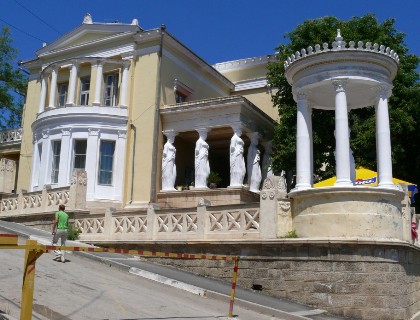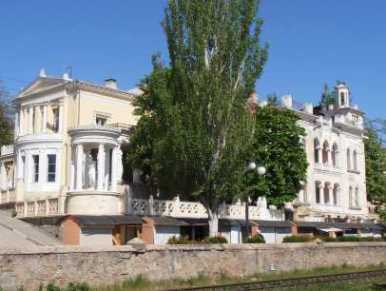

Location: Feodosiya

Dacha Milos (also known as Villa Milos) is a prominent early 20th-century architectural landmark in Feodosia, Republic of Crimea, Russia, located at 33 Aivazovsky Avenue, near the embankment. The building is an elegant neoclassical mansion with elements of ancient Greek architecture, which has become one of the symbols of the Feodosia resort. The dacha was built between 1909 and 1911 by order of Feodosia merchant Ibrahim Samoylovich Krym, a member of the ancient Karaite dynasty, and named after the Greek island of Milos, home of the famous Venus de Milo statue. The project was designed by Moscow architect Maxim Fedorovich Piskunov, who realized the concept of a luxurious summer home with antique motifs. Today, the dacha operates as part of a sanatorium but remains a popular tourist attraction due to its beauty and historical significance. Coordinates: 45°02′16″ N 35°22′23″ E
The construction of the Milos Dacha commenced in 1909 and wrapped up
by 1911 under the commission of Ibrahim Krym, a prosperous
entrepreneur from a Karaite family with deep historical ties to the
Crimea region. As a notable philanthropist and businessman, Krym
sought to showcase his status through this elegant villa. Reports
suggest that skilled Turkish artisans were involved in the project,
infusing it with unique exotic influences. The name "Milos" draws
inspiration from the Aegean island of Milos, famed for the discovery
of the iconic Venus de Milo statue, which aligns with the classical
motifs prevalent in the dacha's design. This period marked a surge
in resort development in Feodosia at the dawn of the 20th century,
with the Milos Dacha exemplifying the era's opulent coastal estates
that highlighted the wealth and sophistication of their owners.
Following the 1917 Russian Revolution, the property was seized and
nationalized by the new regime. In the Soviet years, it served
initially as a sanatorium for workers and holidaymakers, eventually
integrating into a larger health resort network. The structure
endured damage during World War II (known as the Great Patriotic War
in Russia) but was meticulously repaired postwar. In the era after
the Soviet Union's dissolution, it maintained its prestige as a key
architectural and cultural landmark. Today, it holds official
protection as a cultural heritage site of regional importance in
Crimea. Recent efforts, including restorations in the past decade,
have focused on safeguarding its authentic aesthetic, ensuring it
remains a testament to early 20th-century grandeur amid Feodosia's
evolving landscape.
Nestled on a hillside with commanding views of the Black Sea, the
Milos Dacha is a two-story edifice featuring a semi-basement level.
Designed by architect M. F. Piskunov, it masterfully blends
neoclassical principles with hallmarks of ancient Greek
architecture, such as grand columns, expansive porticoes, triangular
pediments, and ornate details evocative of classical temples. The
exterior boasts a soft light-yellow hue that imparts a bright,
ethereal quality, enhancing its seaside charm. The primary entrance
is accentuated by semi-columns and a prominent triangular pediment,
creating a welcoming yet majestic focal point.
A standout element
is the expansive open terrace spanning the main facade, bolstered by
sturdy columns and embellished with plaster replicas of ancient
sculptures depicting Greek deities and legendary heroes. At the
heart of this display is a reproduction of the Venus de Milo, the
dacha's emblematic centerpiece, positioned within a charming
rotunda-gazebo. This rotunda, a rounded pavilion encircled by a
colonnade and crowned with a dome, occupies the eastern section of
the estate. The terrace is bordered by an intricate balustrade
featuring decorative crosses and ornate flowerpots, adding to the
refined elegance. The overall layout is asymmetrical, with the
western wing appearing more robust—complete with a protruding bay
window and balcony—contrasting the airier eastern side anchored by
the rotunda. Spanning about 0.5 hectares, the grounds include lush
gardens, winding pathways, and sturdy stone retaining walls. While
interiors are typically reserved for guests, they feature generous
rooms with soaring ceilings, elaborate stucco work, and period
fireplaces, characteristic of luxurious villas from that time.
The antique-inspired decor, including the array of plaster statues and the distinctive rotunda, evokes the ambiance of ancient Greece, transforming the dacha into a scaled-down version of the Parthenon—a scarce architectural style in Crimea. Its hillside perch offers breathtaking panoramic vistas of the Feodosia Gulf, a deliberate choice that maximizes the site's natural allure and was pivotal in its original planning. Culturally, the Milos Dacha forms part of Feodosia's ensemble of historic villas, situated near the Stamboli Dacha and other notable estates, and is frequently highlighted in travel guides as a prime specimen of turn-of-the-century resort architecture. The mythological connections through its name and statuary, coupled with owner Ibrahim Krym's reputation as a generous philanthropist and astute businessman, weave in layers of legend and historical intrigue, making it a symbol of Crimea's multifaceted heritage.
As of 2025, the Milos Dacha functions as the Milos Sanatorium, providing health and wellness programs, lodging, and therapeutic treatments to visitors. Post-restoration, the structure is in excellent shape, though internal access is generally limited to registered guests. The exterior, however, is open for public admiration at no cost—stroll along Aivazovsky Avenue to appreciate the facade, sculptures, and grounds. Reaching it is straightforward: a quick 10-15 minute walk from central Feodosia or via public transport to the "Prospekt Aivazovsky" stop. Summer is ideal for visits, when the gardens burst into vibrant bloom, enhancing the scenic appeal. A typical exploration lasts 20-30 minutes and pairs well with nearby attractions like a leisurely walk along the waterfront or a trip to the Aivazovsky National Art Gallery. The Milos Dacha stands as a captivating embodiment of early 20th-century extravagance and elegance, seamlessly blended with Crimea's stunning natural setting, making it an essential destination for enthusiasts of history and architecture.